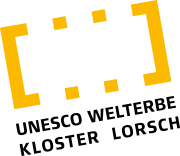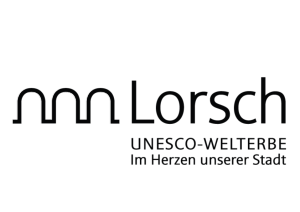
History & significance
From an aristocratic monastery to a royal monastery
Just a few decades after its foundation, Lorsch was already one of the richest landowners east of the Rhine, with estates stretching from what is now the Dutch North Sea coast down to what is now Switzerland in a scattered location characteristic of the early Middle Ages. In 766, a legal dispute arose over the question of ownership between Gundeland and the son of Gaugraf Cancor, but this did not prevent the rapidly expanding monastery from being relocated to the later site (767-774), namely to an ice-age sand dune a few hundred meters from Weschnitzinsel as the crow flies. In 772, Gundeland took the dispute to the last possible legal instance, before the ruler, Charlemagne. Charles ruled in Gundeland’s favor and Gundeland donated the monastery of Saint Nazarius, including all the land, to the king, who thus became the new owner of the abbey.
Privileges and duties
In this way, Lorsch was transformed from an aristocratic monastery into a royal monastery – also endowed with the privileges of immunity and the free choice of abbot, favored by royal protection.
Of course, Lorsch’s status as a royal monastery also entailed duties: Prayer services had to be performed for the king and the dynasty, dona annualia were expected, annual levies and militia had to be paid, military services that were of course not guaranteed by the monks themselves, but by the free vassals of the monastery. There were probably also other obligations: Providing for the ruler and his officials when they were in the vicinity, diplomatic services of the abbots. However, it also becomes clear that a royal monastery in the early Middle Ages was anything but a tranquil place dedicated solely to prayer and contemplation at the grave of a saint. Monasteries are important points in the penetration of the Frankish empire with rule. Their abbots are highly respected, powerful functionaries of the court and thus in the closest environment of the ruler.
High profile visit
Time and again in the history of the Abbey of St. Nazarius, particularly outstanding events have underlined this character: On September 1, 774, for example, when Charlemagne attended the consecration of the Nazarius Basilica in Lorsch with a large entourage on his way from Italy to Fritzlar. This ceremony underlines the early achieved status of the monastery. Just over a century later, immediately after the death of King Louis the German (876), Charlemagne’s grandson, the monastery experienced another important “act of state” in its history: It becomes the burial place of the first “German” king and his dynasty. Louis the German, his son Louis the Younger (d. 882) and his grandson Hugh (d. 879) were buried here. The crypt church built between 876 and 882, which has gone down in the history of the monastery under its old name ecclesia varia, was also later used as a burial place for important personalities, namely the wife of Conrad I, the first non-Carolingian king on the German throne, Kundigunde (died after 915). Around twenty visits by rulers are counted for Lorsch before 1090, and in 1052 there was even a visit by a pope, Pope Leo IX, who consecrated an altar in the Nazarius Basilica, specifically in the adjoining crypt chapel of the East Frankish Carolingians.
It is easy to understand the ruler’s interest in the internal conditions of the abbey, the demands for reform from the center, which at times led to the suspension of the free election of abbots (895-956) and could require abbots appointed by the ruler, so-called commendatary abbots, among them such important personalities as the abbot-bishop Adalbero of Augsburg or Archbishop Brun of Cologne, the brother of Otto the Great. It was Brun in particular who created the conditions for the monastery to flourish again: In 951, he introduced the ordo Gorziensis in Lorsch and even built the monastery into a center of this reform movement: Corvey, Fulda, St. Gallen, St. Martin (Cologne) and Amorbach were reformed from here in the spirit of the Gorzian movement. In 956, Otto I restored Lorsch to its former rights and strengthened it economically through privileges; between 956 and 1067, Bensheim (956), Stein (995), Weinheim (1000), Brumath in Alsace (1000), Oppenheim on the Rhine (1008) and finally Lorsch itself (1067) were places where the abbey had privileged markets and mints.
Abbot Udalrich and the Starkenburg castle
Abbot Udalrich of Lorsch vigorously resisted an attempt to lift the immunity: Starkenburg Castle was built within sight of the monastery and in 1066 Udalrich appeared in Trebur with a massive contingent of 1,200 armed horsemen to dissuade the young ruler from his plans. In general, Lorsch seems to have experienced a third high point under the aforementioned abbot, which can be seen in the activity of the scriptorium as well as in the vigorously pursued development of new settlement and economic areas in the Odenwald. Between 863 and 875, the beginnings of a branch monastery were laid on the Heiligenberg near Heidelberg, but its activation only really got underway in 1023. In 1071, the Lorsch mother monastery, now called Altenmünster, was established as a provostry, and finally, around 1130, the Neuburg am Neckar monastery, also near Heidelberg, may have been founded, which is the only Benedictine abbey still in existence today.
However, the immunity status of the abbey had been attacked – and at this time this meant not only that the ruler had exercised a right to which he was entitled, but also that the spiritual and secular imperial aristocracy, which had long shared in the power of government, could in turn pose a threat to the immunity of a monastery such as Lorsch. Another phenomenon is the steadily decreasing availability of land by the monastery; the reasons for this lie in the development of the feudal system and in the possibilities of powerful feudal holders of the abbey to “alienate” monastic property and increasingly to pursue their own “politics”, which under certain circumstances intersected with the interests of the monastery.
End of the Benedictine era
Both phenomena form the background to the loss of the monastery’s immunity in 1229. The implementation of the new legal status can be equated with the end of the Benedictine era, which, according to tradition, was even carried out by force.
From 1232 to 1248, Cistercians lived within the walls of the abbey, and in 1248, Premonstratensians from Allerheiligen in the Black Forest settled in the monastery. In its time, the monastery lost its former importance and developed into a more regional center. However, the idea of a complete loss of importance is not justified: In the 14th century in particular, the provostry was probably still in a position to carry out elaborate building work, which characterizes the image of the monastery that Matthäus Merian has handed down to us.
The Lorsch Premonstratensian community experienced the pledging of the monastery to the Electoral Palatinate in 1461, and Lorsch was still under their control in 1556 when Elector Ottheinrich of the Palatinate enforced the Reformation in his domain and dissolved the monasteries. Lorsch was not returned to the Archbishopric of Mainz until 1623; by then, however, the once flourishing place of monastic life had long since become a field of ruins: In 1621, Spanish troops devastated the monastery complex, which had since served as a quarry for the entire region for many decades.
Dr. Hermann Schefers



